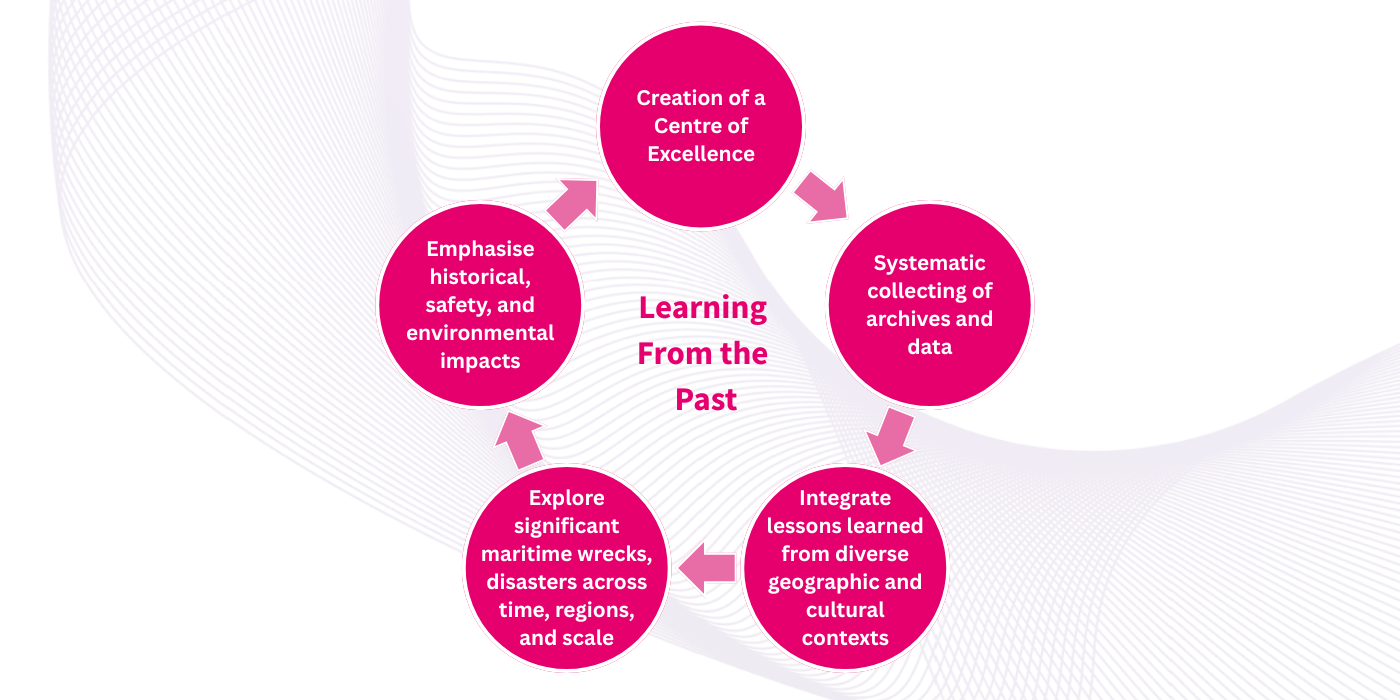Maritime disasters continue to pose significant risks to human life, the environment, and global trade. Hazardous shipwrecks leak pollutants into delicate marine ecosystems, while historic safety failures—such as inadequate evacuation procedures or insufficient weather preparation—continue to inform modern challenges. Despite the wealth of data on individual shipwreck incidents, there is no comprehensive platform to study their patterns, analyse root causes, or provide accessible insights for future prevention. This initiative seeks to address this gap through research, collecting, and public engagement on maritime disasters and their consequences.
We seek to explore establishing a Centre of Excellence focused on the study, documentation, and public engagement regarding shipwrecks, maritime disasters, and the environmental and safety challenges they present from 1760 to the present day. This initiative aligns directly with the Foundation’s mission to promote safety and sustainability in the maritime industry, addressing critical historical and contemporary issues such as hazardous and polluting wrecks, evolving safety standards, and environmental threats.
About Theme 3: Shipwrecks and Maritime Disaster
- Insights from Shipwrecks: Shipwrecks provide fascinating insights into the past, including famous names, vivid stories, remarkable artefacts, global connections, tragic losses, and universal narratives that captivate the public imagination. They are also active biodiverse and navigationally crucial markers in a global maritime system.
- Learning from Maritime disaster: Numerous incidents have profoundly impacted global oceans and human progress, shaping safety regulations and highlighting marine ecosystem vulnerabilities. Despite this, there is no centralised effort to consolidate these lessons into actionable insights for the future. The Centre of Excellence will bridge this gap, leveraging the Foundation’s expertise and international influence to advance maritime safety, resilience, and sustainability.
- Enhancing Influence: This theme presents a significant opportunity to elevate the Heritage Centre’s standing and influence among a broader audience and set of stakeholders, enhancing its ability to fulfil its mission.

Challenges in Maritime Safety
Efforts to systematically analyse shipwrecks to identify broader patterns or root causes are limited and often focused on specific cases or sectors. For example:
- Regulatory Responses: Responses to disasters (e.g., the Titanic and SOLAS) often address immediate safety gaps but do not always engage in deeper, interdisciplinary pattern analysis.
- Focus on Modern Incidents: Maritime safety organisations like the International Maritime Organization (IMO) and classification societies concentrate on modern incidents, leaving historical insights under-utilised.
- Limited Collaboration: Marine archaeologists and historians often lack access to or collaboration with safety regulators, restricting the practical application of their findings.
- Accessibility Issues: Existing resources are frequently inaccessible to the broader public and stakeholders outside specialized circles. Reports and databases are often technical, behind paywalls, or regionally restricted. Few initiatives focus on public engagement or provide digestible insights that bridge historical lessons with modern maritime safety challenges.
- Fragmented Efforts: While no single comprehensive initiative exists, some efforts address overlapping aspects. For example, UNESCO Underwater Cultural Heritage programs focus on protecting historical wrecks, though not primarily on safety lessons. Marine environmental organisations address polluting wrecks and their impacts, though their scope is narrowly environmental. Industry safety bodies, such as the IMO, focus on applying lessons to modern safety but lack integration with historical studies. There are lots of opportunities to collaborate on Learning from the past.
- Increasing Decay of Wrecks: There is substantial evidence that the decay of wrecks (e.g., approximately 8,500 from WWI and WWII) is accelerating, posing a growing risk to local livelihoods and environments. Knowledge and best practices regarding wrecks must be readily available for when catastrophes occur. Project Tangaroa works to bring experts together around this challenge.
- Fragmented Data: There is a wide array of data on individual shipwrecks, including historical records, case studies, and environmental impact assessments. However, this information is often fragmented across specialized fields, such as maritime history, marine archaeology, environmental science, and accident investigation reports. Much of this data is siloed within organizations like maritime museums, universities, environmental agencies, and private archives. Mapping this will be the first step.
- Lack of a Unified Platform: Currently, there is no single, globally recognised platform that integrates these disparate sources into a unified resource. While there are organisations and initiatives that focus on certain aspects of shipwrecks, such as UNESCO’s work on underwater cultural heritage or databases like NOAA's Wrecks and Obstructions Information, a comprehensive platform is still lacking. These platforms typically prioritise specific themes, such as cultural heritage, environmental hazards, or regional data. How can the lessons from the past be mobilised to inform a safer future?
Objectives and Scope
- Collecting Archives and Data: The Heritage Centre will gather archives and data, exploring significant maritime wreck disasters across various times, regions, and scales, with a focus on their historical, safety, and environmental impacts.
- Developing a Global Perspective: By studying these and other cases, the Centre will develop a global perspective, integrating lessons learned from diverse geographic and cultural contexts, and learning from past failures.

